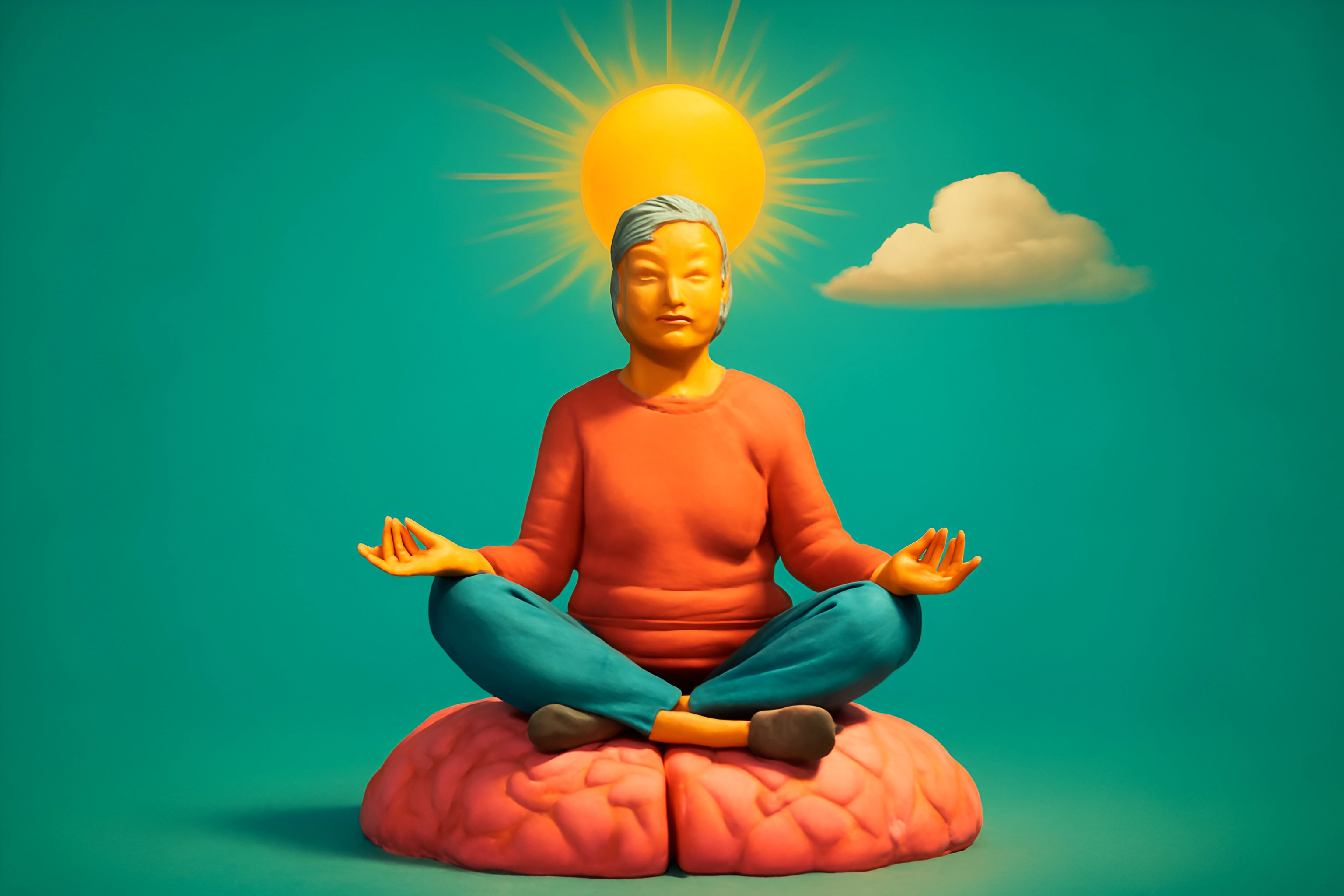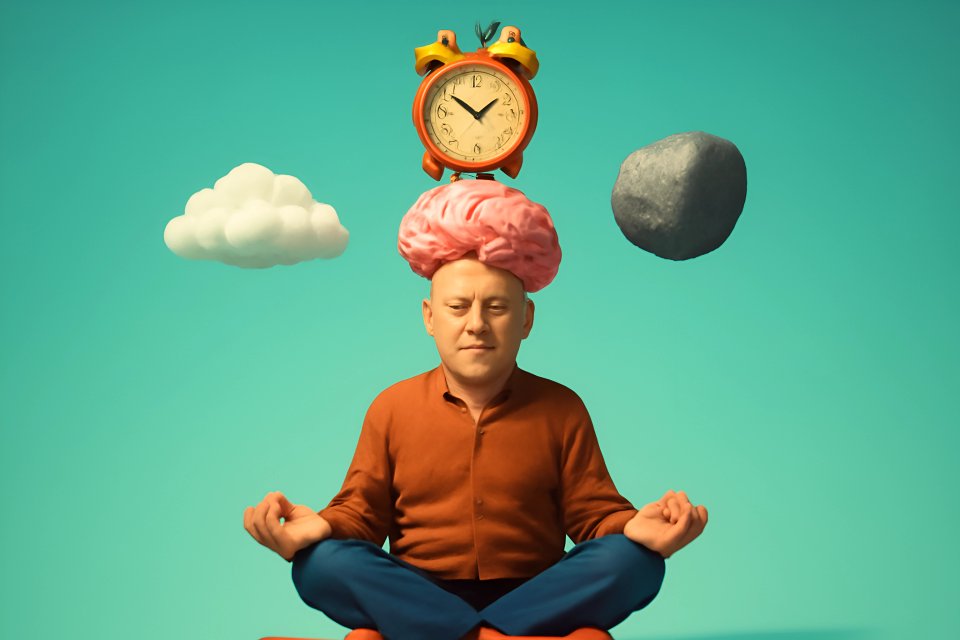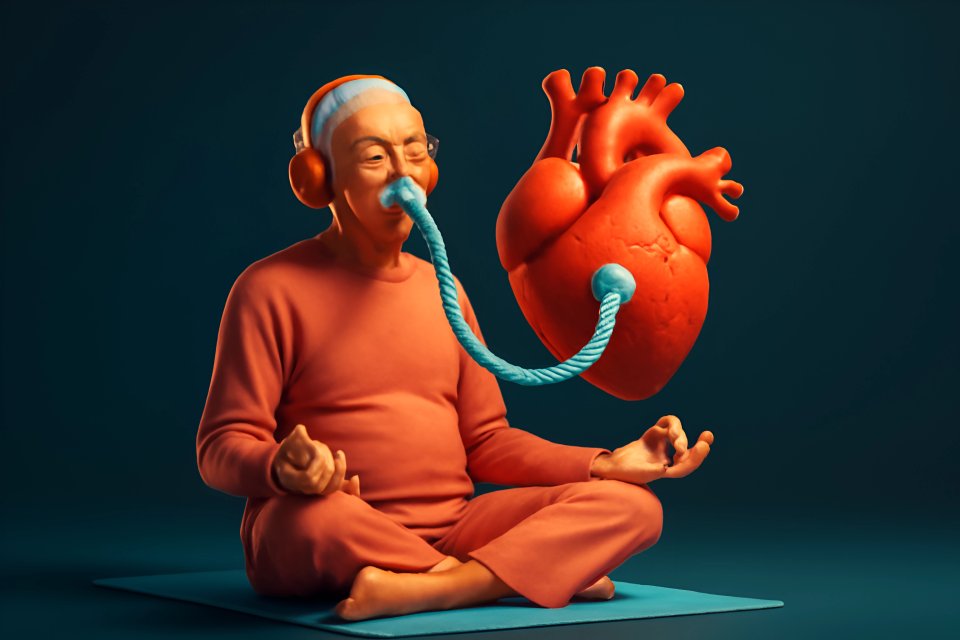
Your Invitation to a Calmer, Clearer Mind
Does your mind feel like it's running a marathon, even when your body wants to rest? Between planning for the future, managing your health, and keeping up with family, finding a moment of genuine peace can feel like an impossible dream. You’re not alone in this feeling, and the constant mental noise is exhausting.
But what if you could find the off-switch? What if you had a simple, practical tool to quiet the chatter and reclaim your inner calm? This is the promise of guided meditation—not as a complex spiritual practice, but as a straightforward workout for your brain, designed to build mental fitness and resilience.
In this guide, we’ll demystify guided meditation for beginners over 50, showing you exactly how to start, why it’s so incredibly beneficial at this stage of life, and how to make it a comfortable and rewarding part of your daily routine. No experience is necessary, no pretzel-like poses are required, and this is a completely judgment-free zone.
What Exactly is Guided Meditation? A Friendly Definition
Forget everything you think you know about meditation. This isn't about forcing your mind to go blank—an impossible task for anyone. Think of guided meditation as having a calm and steady coach for your mind, gently talking you through a process of relaxation and focus.
A soothing voice guides your attention, perhaps to the sensation of your breath or a peaceful image, leading you away from the endless loop of worries, to-do lists, and what-ifs. The goal isn't to stop your thoughts; it's to learn how to observe them without getting swept away. As one guide on meditation tips for women over fifty explains, it's about understanding your personal "why" to stay motivated, whether that's for better sleep or less anxiety.
This simple act of guided focus is a powerful way to train your attention and cultivate a sense of inner peace. It’s a skill that strengthens with practice, just like any muscle. And the best part? You can start seeing the benefits in just a few minutes a day.
The Unique Benefits of Mindfulness for Older Adults
Why is this practice gaining so much traction, especially for those of us over 50? Because the benefits directly address the challenges and goals that come with this vibrant chapter of life. It’s a holistic tool that supports both mental and physical well-being in profound ways.
This isn't just about feeling good; it's about tangible health improvements. For instance, studies have shown that consistent meditation can help lower blood pressure and reduce inflammation, two critical factors in healthy aging. According to Senior Lifestyle, the list of healthy benefits of meditation for seniors includes everything from immune system support to improved pain control.
Here’s a look at what a consistent mindfulness practice can do for you:
- Stress & Anxiety Reduction: It provides a powerful antidote to the stress that can accompany life transitions, health concerns, or caregiving responsibilities.
- Improved Sleep Quality: It’s a natural, side-effect-free way to quiet a racing mind before bed, paving the way for deeper, more restorative sleep. For more on this, explore our guide to mindful habits for better sleep.
- Enhanced Focus & Mental Clarity: It helps cut through the "brain fog" that can sometimes creep in, sharpening your focus and keeping your mind agile.
- Emotional Balance: By creating space between your thoughts and your reactions, you can cultivate a greater sense of calm and resilience in the face of life's ups and downs.
- Support for Physical Well-being: Beyond lowering blood pressure, meditation can help manage the perception of chronic pain and even improve balance, linking mental clarity directly to physical stability.
Getting Started: Your Simple 5-Minute Mindfulness Exercise
Ready to feel the calm for yourself? This simple, five-minute exercise is your starting point. There's no right or wrong way to do it—only your way.
Step 1: Find Your Comfortable Seat
First, forget the idea that you need to sit cross-legged on the floor. A supportive chair where your feet can rest flat on the ground is perfect. This is a key age-adapted meditation technique. Sit with your spine tall but not stiff, and let your hands rest comfortably in your lap.
Step 2: Set a Gentle Timer
Use your phone or a kitchen timer and set it for just three to five minutes. Knowing there's a defined end point removes any pressure to meditate for a long time. You can always do more later, but for now, five minutes is a victory.
Step 3: Settle In
Allow your eyes to gently close, or if you prefer, soften your gaze and look down toward the floor. Take a slow, deep breath in through your nose, and let it out with a sigh through your mouth. Do this two or three more times, letting each exhale release a bit of tension.
Step 4: Follow the Guidance
Now, simply bring your attention to your breath. Don't try to change it; just notice it. Feel the air entering your nostrils, filling your lungs, and the gentle release as you exhale. When your mind wanders (and it will!), just gently notice the thought and guide your focus back to your breath. You can follow this simple internal script:
“Notice the feeling of your feet on the floor, solid and supported. Bring your attention to your breath, feeling the gentle rise and fall of your chest. In... and out. If a thought comes, just acknowledge it, and gently return to the breath. In... and out.”
Step 5: Gently Conclude
When your timer goes off, don't jump up right away. Slowly bring your awareness back to the room. Wiggle your fingers and toes. When you're ready, gently open your eyes. Take one final moment to notice how you feel—perhaps a little calmer, a little quieter, a little more present.
"But I Can't..." Overcoming Common Meditation Challenges
It’s completely normal to hit a few bumps when you start a new practice. The key is not to let them derail you. Here are the most common hurdles and simple, practical solutions to keep you on track.
Challenge: "My mind is too busy and won't stop wandering!"
This is the number one concern for beginners, but here’s the secret: a wandering mind is not a sign of failure. It’s a sign that you’re human! The actual practice of meditation is the gentle act of noticing your mind has wandered and kindly guiding it back, over and over again. Every time you do this, you are strengthening your focus "muscle."
Challenge: "Sitting still is uncomfortable. My back/knees/hips ache."
Your comfort is paramount. If sitting in a chair is painful, it’s time to adapt. This is where age-adapted meditation techniques are essential. Try placing a cushion behind your lower back for support, or even try meditating while lying down on a yoga mat (just be aware it might make you sleepy!). For those who need to move, a slow, mindful walking meditation can be just as powerful. You can also explore gentle practices like in our guide to integrating yoga for mobility and stress relief.
Challenge: "I feel like I'm not doing it right."
Let go of the idea of a "perfect" meditation. There is no such thing. If you took a few minutes to sit and intentionally breathe, you did it right. Some days will feel calm and focused, while others will feel scattered and restless. Both are part of the journey. The goal is simply to show up for yourself without judgment.
Making Meditation a Sustainable Habit
The incredible benefits of meditation come from consistency, not duration. A daily five-minute practice is far more powerful than a 30-minute session once a month. Here’s how to weave this practice seamlessly into your life.
Start small and stay there for a while. The power of just five minutes a day cannot be overstated. It’s an achievable goal that prevents you from feeling overwhelmed and makes it easy to show up, even on busy days.
The secret to building any new habit is to link it to an existing one. This is called "habit stacking." For example, decide to meditate for five minutes right after your morning cup of coffee, or right before you brush your teeth at night. The old habit becomes the trigger for the new one, automating the process. As experts on meditation for women over 50 suggest, consistency is more important than duration.
Finally, identify a time of day when you need it most. Do you need to ground yourself before the day begins? Do you hit a mid-afternoon slump and need a reset? Or do you need to decompress and let go of the day before bed? Tying your practice to a specific need makes it feel less like a chore and more like a gift to yourself. For a deeper dive, check out our guide on mindful evening routines to optimize sleep.
Where to Find Free and Easy-to-Use Guided Meditations
Once you’ve tried the five-minute practice, you’ll likely want a friendly voice to guide you. Luckily, there are countless free and accessible resources available to support your journey. You don’t need to spend a dime to get started.
Many user-friendly smartphone apps offer free introductory sessions and a library of guided meditations. Popular choices like Insight Timer, Calm, and Headspace are excellent tools for beginners, offering a variety of styles and durations led by soothing voices. These apps make it easy to find a practice that fits your mood and schedule.
YouTube is another treasure trove of resources. Simply searching for terms like "5-minute guided meditation for seniors" or "beginner mindfulness for stress" will yield thousands of high-quality videos. This Guided Meditation for Seniors is a wonderful example, offering a gentle 10-minute session focused on stress relief.
Finally, don't overlook podcasts. Many wellness and mental health podcasts regularly feature free guided meditations. This is a great option if you prefer audio-only guidance that you can listen to during a quiet moment or even on a gentle walk. As the Art of Living Foundation notes, guided meditation is an easy entry point for seniors looking to ease into mindfulness.
Your Journey to a Calmer Mind Starts Today
You now have everything you need to begin. Guided meditation is not some far-off, complicated concept; it is a simple, accessible, and profoundly powerful tool for enhancing your well-being, especially after 50. It’s a way to train your mind for more calm, clarity, and resilience.
Investing in your mental wellness is just as important as physical fitness. You have the power to cultivate peace and clarity, one breath at a time. It's never too late to begin your journey inward.
Ready to give it a try? Commit to the 5-minute practice this week and share your experience in the comments below. We’d love to hear from you.
















